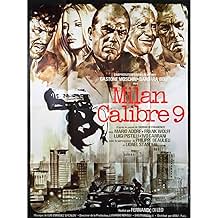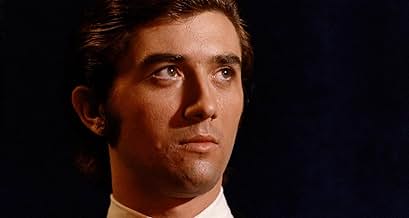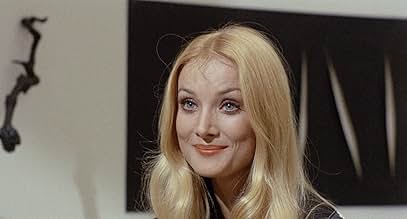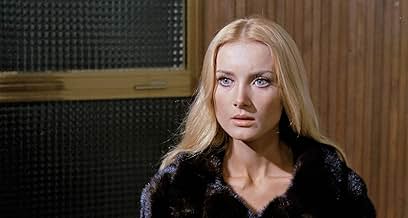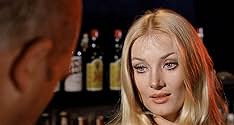Un antiguo gánster se ve obligado a retomar su antiguo estilo de vida cuando tanto sus viejos compañeros, violentos y celosos, como la policía creen que conoce la ubicación de un alijo robad... Leer todoUn antiguo gánster se ve obligado a retomar su antiguo estilo de vida cuando tanto sus viejos compañeros, violentos y celosos, como la policía creen que conoce la ubicación de un alijo robado de 300 000 dólares.Un antiguo gánster se ve obligado a retomar su antiguo estilo de vida cuando tanto sus viejos compañeros, violentos y celosos, como la policía creen que conoce la ubicación de un alijo robado de 300 000 dólares.
- Dirección
- Guión
- Reparto principal
Reseñas destacadas
The main reason why this film excels is thanks to the fantastic performances. Gastone Moschin leads the film with a performance that reminded me of something Ray Winstone would deliver. He provides a likable anti-hero, while Mario Adorf gets to enjoy himself with the meatiest role in the film. Barbara Bouchet co-stars and looks great, especially in her dancing scene in a bar. Bouchet is one of my absolute favourite Italian actresses, and I always enjoy seeing her in films - especially when they're up to the standard of this one. The film does somewhat adhere to the pitfall plaguing many Italian thrillers - that being that the story doesn't always make sense, but generally; the plot flows really well and the twists and turns ensure that it never gets boring. The climax of the film is excellent, and director Fernando Di Leo excellently pulls off the double twist at the end, which both resolves the story and provides neat entertainment. Overall, Milano Calibre 9 may not be the most well known cult Italian film - but it's one that shouldn't be missed by fans of this sort of stuff, and therefore comes highly recommended.
Those sympathetic to early seventies fashion and music are in for a real treat. Osanna/Bacalov's music is totally uncompromising and - in my honest opinion - worth a hundred times the entrance money in its own right. This may be the best soundtrack ever! The visuals are also astonishing - timeless in their beauty, but still with a strong flavour of early 70s. And you'll also catch some glimpses of what must be the world's most beautiful woman.
In sum, all this simply makes up a classic. NOT TO BE MISSED!
(Those who already own the soundtrack, which actually seems easier to find than the movie, should be advised that the movie has alternate versions, all brilliant).
That doesn't stop Rocco harassing the hell out of him, however. First he's taken to a scrapyard to have the crap beaten out of him, then Rocco and his goons turn up at Ugo crap hotel and destroy the place, but Ugo still denies taking the cash. Ugo goes to his old partner Phillip Leroy for help, but the man can only offer him money and advises him to go see the Mikado (although he does give Rocco a kicking for good measure).
The Mikado, knowing that if Ugo has the money, then there's no point in killing him, hires him as a runner and has him work for Rocco, but things go from bad to worse when a red-clad figure who has been following Ugo kills one of the goons, steals more cash, and sets in motion a series of events that ends in a bloodbath. I suppose this being 1972 they had to throw in a mysterious killer somewhere.
This all sounds like your usual Euro-crime movie, but there also an ongoing socio-political debate between two cops (An animated Frank Wolff and a subdued Luigi Pistilli) about the differences in the rich and the poor, and the North and the South of the country. This is reflected in the Mikado's speech about the old and new mafia, and how honour is not practised by the 'new' criminals, which is something that comes back to haunt the film's bleak ending.
Just about every actor involved here stands out. Phillip Leroy tries to live in peace but his hand is forced by events beyond his control – his weary resignation at what he has to do in the end is a highlight, Gastone Moschin is no oil painting but as the quiet, brooding lead plays a very good burned out criminal, but Mario Adorf blows them all of the screen as the manic 'moustache Pete' who may be violent and cruel, but still knows how to stick to the code of honour. His character is no fool either, as a tense, and mostly silent scene between Ugo and himself in a police station shows.
The soundtrack is a killer too! Although not my favourite Poliziotteschi film (for that is what they are called), it's probably my favourite Fernando De Leo film. Oh! Special mention to the set design of Barbara Bouchet's flat – amazing use of black and white.
This was one of two films released after Frank Wolff's suicide. His co- star here, Luigi Pistilli, would also go on to commit suicide after receiving bad reviews and having a public meltdown (much later, in 1996). On a happy note Phillip Leroy and Mario Adorf still walk the Earth!
Violent poliziesco with thrills, high body-count, grisly killings, twists and turns. Interpretations are pretty good, Gastone Moschin is very well as a sober, slow-talking ex-con who is forced to resume his previous criminal life when his former colleagues believe he knows the wherebout of a stolen cache that should have gone to an American gangster . Support cast is frankly excellent as Mario Adorf playing a psychopatic mobster with penchant for sick violence and enjoying torturing who will stop at nothing to get his purports, the always gorgeous Barbara Bouchet as a strip-tease dancer, Frank Wolff as an obstinate commissioner, Luigi Pistilli as his helper who has a visceral hate for wealthy people , Ivo Garrani as a blind, honorable mobster called Don Vicenzo , Mario Novelli or Anthony Freeman as a henchman named Pasquale and Lionel Stander as revengeful drug ringleader called The American or Mikado.
It contains a moving and thrilling musical score by prestigious Luis Enrique Bacalov, who got an Academy Award for The postman and Pablo Neruda. And atmospheric and evocative cinematography by Franco Villa. The picture was well written and directed by Fernando Di Leo. He was an expert writer and filmmaker. Firstly, he wrote notorious Spaghetti Westerns as Fistful of dollars, For a fistful of dollars more, Ringo , The return of Ringo, Johnny Yuma, 7 guns for the McGregor, 7 women for the McGregor, Sugar Colt, Johnny Yuma, Joe implacable, The ruthless four, Wanted. Turning in direction he made sex comedies as Loaded guns, Italian sex, La seduczione and Victims of lust. Outstanding in Poliziesco subgenre, often starred by Henry Silva, Richard Conte, Mario Adorf, Luc Merenda, including as follows : I boss, The American connection, La mala ordina, Shoot first die later, Running guns, Madness, The boys who slaughter, Razza violenta, Killers vs Killers, among others. Rating 7/10. Better than average Italian cop movie. Essential and indispensable watching for this sub-genre buffs.
Mario Adorf gives a performance that brings to mind Joe Pesce in Goodfellas(1990) and Casino(1995), Takeshi Kitano in Boiling Point(1990), and Lee Marvin in The Big Heat(1953). He is excellent as the mafia hood with a sadistic streak. Mario Adorf plays his character with unbelievable and vicious conviction. His performance is one of the best acting jobs from the film.
This movie along with La Mala Ordina/Hired to Kill(1973) and Il Boss/The Boss(1973) makes Fernando Di Leo the Italian eqivulent of Jean Pierre Melville. Fernando Di Leo is influenced by Melville in many aspects. Milan Calibre 9(1972) reminds me of Le Doulos(1961) with their use of anti heroes. One of many films that Jean Pierre Melville made an impression on.
Has a double plot twist which is utilized in cleaver and unpredictable fashion. I was surprised by the first plot revealing twist. I was convincing stunned by the second plot revealing twist which was much more unexpected. The double plot twist is one characteristic that makes the film special.
Fernando Di Leo stands out in the gangster craze of Italian cinema in the same way that Sergio Leone stood out as a master of Italian Westerns, Dario Argento as a master of Giallos, and Lucio Fulci as a master of Italian Zombie pics. He brings out a direction full of passion and spunk. The director films the violent scenes with panache and piazzazz. An underrated filmmaker in Italian cinema.
Soundtrack of Milan Calibre Nine is awesome and cool. Luis Enriquez Bacalov is excellent at performing music for Italian Crime and Western motion pictures. The Police are depicted in a cynical and unsympathetic light. The only Police officer who comes out in a sympathetic tone is Fonzino who's only in the movie for a few minutes.
The major action sequence in Milan Calibre 9(1972) prefigures John Woo. What's so twisted about the end of the motion picture is its Rocco whose the most trust worthy person in the entire story. Gastone Moschin gives a gripping performance as a man who cannot escape his tragic fate. Some wonderful performances are handed out by Barbara Bouchet, Philippe Leroy, and Lionel Stander.
The scene where Nelly Bordon played by Barbara Bouchet is doing an erotic dance is filmed with multiple camera angles. An sensual introduction to the character of Barbara Bouchet. The editing in this one scene is good and imaginative. Barbara Bouchet is definitely one of the beautiful women from the 1970s when one sees Milan Calibre 9(1972).
An example of the growing popularity of the gangster movie in Italy. Milan Calibre 9(1972) is in my opinion belongs among the top ten of Italian gangster pictures. The Godfather(1972) may have influenced the gangster film in Italy during the 1970s, but Milano Calibro 9(1972) takes on a life of its own. I've was very impressed by Milano Calibro 9(1972) that I've taken an interest in other films from this genre and decade in Italian cinema.
Provided many influences and inspirations for filmography of Quentin Tarantino. His portrayal of tough guys in his films takes a page out of Milan Calibre 9 as well as other mafia features by Fernando Di Leo. The sadistic violence and unpredictable plot twists can be seen in Resevoir Dogs(1992) and Pulp Fiction(1994). No one filmmaker has influenced Tarantino more frequently besides Jean Pierre Melville than Fernando Di Leo.
¿Sabías que...?
- CuriosidadesFernando Di Leo admitted that, with a critical eye, the scenes at the Police Station among the "fascist" Commissario and the "communist" Mercuri should be taken off because they take strength out of the main story. But the work of actors Frank Wolff and Luigi Pistilli was so good that he couldn't absolutely cut it off.
- PifiasDuring the brief gun fight, the handgun sound effects do not match the barrel flashes. One flash, 3 gunshots.
- Citas
Rocco Musco: [in Italian version]
[last lines, grabbing Luca's hair]
Rocco Musco: You... do not kill a man like Ugo Piazza, TREACHEROUSLY!
Rocco Musco: [slams Luca's head on the edge of the cabinet for the first time] You... shouldn't even touch a man like Ugo Piazza!
Rocco Musco: [slams Luca's head on the edge of the cabinet for the second time] You... should NEVER EVER touch a man like Ugo Piazza!
Rocco Musco: [slams Luca's head on the edge of the cabinet for the third time] You... when you see someone like Ugo Piazza, YOU HAVE TO TIP YOUR HAT!
Rocco Musco: [slams Luca's head repeatedly until he dies and then spits at his corpse] TIP YOUR HAT! TIP YOUR HAT! TIP YOUR HAT! TIP YOUR HAT!
- ConexionesFeatured in History of the Erotic Cinema (1982)
Selecciones populares
- How long is Caliber 9?Con tecnología de Alexa
Detalles
- Fecha de lanzamiento
- País de origen
- Idiomas
- Títulos en diferentes países
- Calibre 9
- Localizaciones del rodaje
- Sempioni Park, Milan, Lombardia, Italia(Opening shots)
- Empresa productora
- Ver más compañías en los créditos en IMDbPro
- Duración
- 1h 42min(102 min)
- Color
- Relación de aspecto
- 1.85 : 1

